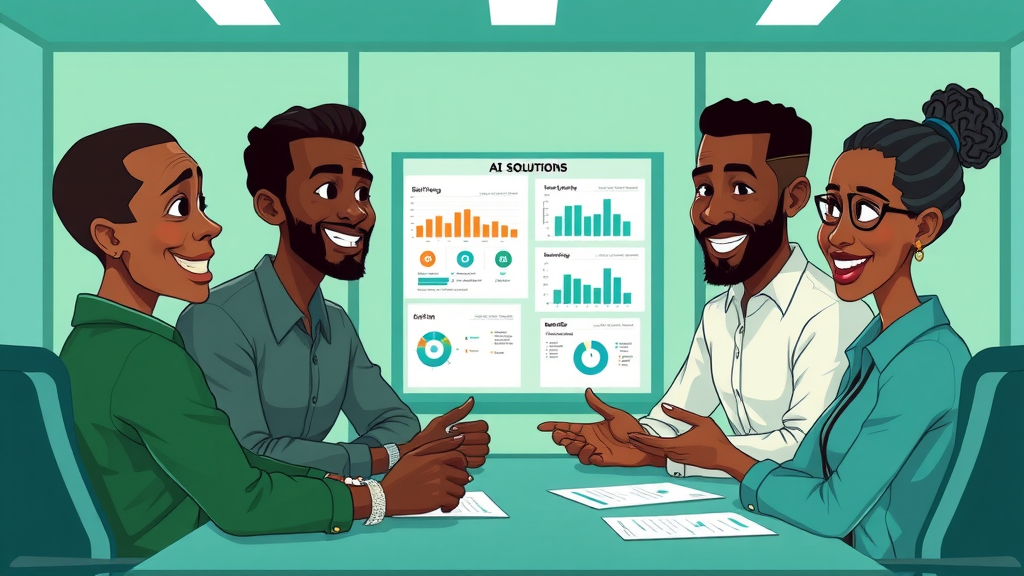
Did you know? The past year alone has seen a 40% spike in advanced AI chip prices across global markets — and nowhere is the impact more sharply felt than in Africa, where the burgeoning AI revolution is colliding with fragile supply chains and importing challenges. As artificial intelligence platforms and machine learning tools redefine what’s possible in finance, healthcare, and agriculture, African innovators face a mounting challenge: the surging cost and severe scarcity of the very hardware — semiconductors and specialized AI chips — they need to drive progress.
A Startling Surge: The AI Hardware Arms Race in Africa
"The surging global demand for AI-driven technologies has led to a 40% spike in advanced chip prices in the past year alone."
Africa is currently witnessing the full force of the AI hardware arms race, a phenomenon that’s no longer confined to the halls of Silicon Valley or the manufacturing hubs of East Asia. As generative AI models and AI systems demand ever-greater computational power, competition for semiconductor manufacturing and access to cutting-edge hardware is heating up across the continent. This explosive demand – powered by AI-driven platforms in fintech, edtech, healthtech, and logistics – is colliding with a supply chain landscape that’s import-dependent, frequently disrupted, and chronically under-resourced.
African tech communities, once excited by the potential of AI to leapfrog traditional infrastructures, are now contending with the harsh economics of hardware scarcity. The result is that prices for AI-enabling chips, AI data center equipment, and related technology have soared, often outpacing the global average. For African entrepreneurs, developers, and businesses alike, this new reality intensifies the need for resourcefulness, local partnerships, and collaborative problem-solving to sustain Africa’s digital future.
What You'll Learn in This Analysis of How the AI Revolution is Triggering a Hardware Arms Race and Pushing Up Prices
The link between AI development and semiconductor shortages in Africa
How generative AI is driving an arms race for specialized chips
Impacts of supply chain constraints on African tech economies
Potential strategies to address these challenges
Decoding the AI Hardware Arms Race: Global and African Perspectives
Arms Race and AI Development: The Global Context

The AI hardware arms race has gained traction globally, with an unprecedented surge in the race for dominance over AI chips and data centers. Major tech giants in the United States, European Union, and Asia are investing billions in semiconductor manufacturing and AI research to outpace their competition. The urgency is driven by the boom in generative AI — think ChatGPT, Bard, and image generators — which rely on powerful AI chips, mainly Graphics Processing Units (GPUs) and specialized Tensor Processing Units (TPUs). As these computational demands soar, global supply chains have become competitive battlegrounds, with export controls and geopolitics shaping who gets access to the most advanced technology.
For Africa, this means entering the arena with significant handicaps: the continent lacks leading semiconductor manufacturers, depends heavily on imports, and consistently comes last in the queue during global chip shortages. As machine learning and artificial intelligence adoption rates climb, African countries must navigate an inherently unequal landscape by forming strategic partnerships and investing wisely in local capacity.
The African Angle: Generative AI Accelerating Hardware Competition
With the sweeping arrival of generative AI technologies, African startups and established businesses are racing to secure AI chips and related infrastructure. These applications — from AI-powered translation in education to advanced financial analysis in fintech — require a level of hardware that was once optional but has quickly become essential. Yet, the chip market remains skewed by global competition, often leaving African innovators with limited or delayed access to the latest processing units and AI system upgrades.
African tech hubs in Lagos, Nairobi, and Cape Town are feeling the pressure as global demand for AI chips pushes prices higher. The dependency on foreign suppliers — coupled with logistical hurdles at ports and within fragile supply chains — threatens to leave Africa trailing in the AI development race. Without intervention, this could widen the technology gap, even as African markets demonstrate an extraordinary hunger for AI-driven economic growth.
AI Chips at the Core: Why Hardware Dictates Progress
AI Chips and Data Centers: The Power Struggle for AI Dominance

At the heart of the AI revolution are specialized AI chips driving computation inside sprawling data center facilities. In Africa, a new generation of AI data center infrastructure is rapidly expanding, serving not just global tech giants but increasingly, local startups and public institutions. These data centers are vital for training and deploying modern machine learning models and managing vast streams of AI data generated by mobile payments, health platforms, and digital agriculture.
Yet, despite ambitious plans, African data centers grapple with unique constraints. The cost and complexity of importing high-performance AI chips — exacerbated by custom controls and fluctuating exchange rates — mean that deployment often lags behind the global average. As a result, African platforms may find themselves stuck with outdated hardware, limiting the sophistication and efficiency of AI services provided to end users, and impeding Africa’s contribution to the wider AI industry.
Semiconductors and the African Hardware Market
"Africa’s data center capacity is forecasted to triple by 2025, but the chip supply remains a critical bottleneck." – TechAfrica News
The crux of Africa’s AI hardware struggle lies within the semiconductor supply chain. The chip market is dominated by a handful of global players based in the United States, East Asia, and increasingly, the EU. African markets are reliant on imports for nearly all high-end chips, with limited capacity for domestic semiconductor manufacturing or assembly. While capital expenditure on new facilities and tech parks is growing, supply chain weaknesses mean that even the most well-funded African projects often wait months for life-critical chips.
This reliance not only exposes African enterprises to price volatility in the global AI chip market but also introduces considerable national security and economic vulnerabilities. As investment continues to pour into local AI research, addressing these bottlenecks must become a strategic priority for governments and tech ecosystems alike.
How AI Development is Dependent on Robust Supply Chains
Robust supply chains form the unseen backbone of successful AI development. The growing sophistication of AI systems and demand for advanced AI chips have made Africa’s over-reliance on long, complex import routes a clear weakness. Even minor disruptions — from global semiconductor shortages to port congestion and trade policy shifts — can have a cascading effect, delaying everything from startup launches to national digital transformation projects.
With many African economies still reeling from pandemic-era transport shocks, the need to insulate AI development from chronic hardware delays is urgent. Strategic stockpiling, regional assembly hubs, and public-private investor coalitions are emerging as promising tactics to guard against future supply-side shocks and help sustain Africa’s place in the global AI industry.
Supply Chain Disruptions: The Achilles' Heel in Africa's AI Revolution
Supply Chain Complexities and the Arms Race for Chips in Africa

Africa’s dependency on imported AI hardware is complicated by fragmented logistics, variable customs enforcement, and precarious partnerships with third-party suppliers. These supply chain complexities not only slow down access to AI chips but also drive up hardware acquisition costs across the board. The challenges are amplified as African companies scramble to secure scarce inventory alongside tech companies and cloud providers in global markets, all racing to capitalize on AI’s promise.
For African economies, delays and markups on AI chip imports can stifle innovation — from national digital ID systems to fintech and agritech rollouts. Startups, often lacking the capital of global tech giants, are particularly vulnerable, risking missed opportunities and competitive disadvantage in the rapidly expanding global AI sphere.
Geopolitics, AI Technologies, and African Investments
Geopolitical tensions over semiconductor supply and AI technology regulation are reshaping Africa’s options for hardware procurement. Export controls imposed by the United States, coupled with rising demand for advanced AI technology in Asia and Europe, have made it even more challenging for African nations to negotiate favorable access. African governments and private sector leaders are waking up to the need for greater regional cooperation, collective bargaining power, and bold investment in infrastructure to break free from such structural dependencies long-term.
While some African countries have started to invest in local AI research and pilot chip design projects, the journey to self-reliance will require substantial capital expenditure, technology transfer, and the nurturing of a skilled workforce that can bridge the gap with established global players.
Comparison of AI Hardware Supply Chain Challenges: USA vs Africa |
||
Factor |
USA |
Africa |
|---|---|---|
Chip Production |
Leading chip manufacturers |
Primarily reliant on imports |
Supply Chain |
Disrupted but diversified |
Highly fragile and import-dependent |
Data Centers |
Strong infrastructure |
Rapid but uneven growth |
AI Investment |
High, speculative |
Emerging, targeted |
Generative AI in Africa: Driving Demand and Innovation
Generative AI’s Influence on Data Centers and Infrastructure

Generative AI models are supercharging Africa’s appetite for powerful AI chips and modern data centers. Whether it’s GPT-powered fintech bots, translation services in local dialects, or next-gen health analytics, these applications are creating unprecedented demand for high-performance processing and vast AI data storage. As a result, African cloud providers and telcos are funnelling resources into hybrid and edge data centers designed for AI workloads.
However, deploying capacity at scale remains fraught with challenges. The cost of importing specialized AI chips, building redundant infrastructure, and ensuring stable power supply all conspire to make scaling up expensive and operationally risky — especially compared to larger, diversified global markets. For African innovators, the hurdles are immense, but so too are the opportunities for those who can bridge the gap with creative technological and partnership strategies.
African Startups, Generative AI, and the Great Chip Chase
Notable African generative AI initiatives: Startups in Lagos and Nairobi are piloting local language chatbots, while South African fintechs deploy AI-driven fraud detection and risk-mitigation systems powered by generative models.
Key local challenges compared to the USA: While US startups often benefit from in-country chip production, African startups grapple with long lead times, higher costs, and uncertain customs regimes for AI hardware imports.
Opportunities for African tech leaders: Collaboration, local assembly, and forming consortia to purchase at scale can help mitigate risks, while partnerships with global tech giants can unlock new channels for chip acquisition.
AI Development and Price Dynamics: Who Bears the Rising Costs?
How the Hardware Arms Race Pushes Up Prices in Africa

The most immediate consequence of the hardware arms race is soaring AI hardware prices — with African companies and startups hit the hardest. Each twist in the global chip market is passed along the supply chain, inflating the prices of basic infrastructure needed for AI research, cloud computing, and application development. For many African organizations, this means higher capital expenditure for everything from server upgrades to maintaining AI data centers, making scalability considerably more expensive.
In a competitive environment where resource-rich tech giants can outbid smaller entrants, African businesses face stark trade-offs: delay innovation, scale back services, or absorb additional costs that must eventually be passed on to consumers. Left unchecked, this dynamic risks throttling local AI development, slowing economic transformation, and stifling the emergence of African-led AI solutions.
The Ripple Effect: Consumers, Developers, and Entrepreneurs
"African fintech and edtech platforms are now paying up to 60% more for AI-related hardware than two years ago."
The burden of higher prices ripples out across Africa’s digital societies. For developers, the spike in AI chip prices and cloud services may force delays in releasing innovative machine learning applications. Entrepreneurs in fintech and edtech — already working on slender margins — find themselves squeezed between customer expectations and the harsh realities of global hardware costs. Ultimately, it is African consumers who stand to lose most, as the cost of digital services, mobile transactions, and even online education rise in step with hardware supply challenges.
Many experts now warn that unless Africa can devise creative, contextually relevant solutions to the AI hardware dilemma, the continent risks becoming a testing ground for imported technologies, rather than a birthplace for new, globally relevant AI innovations.
Expert Voices: African Perspectives on the AI Hardware Arms Race

"African innovation cannot thrive unless access to crucial AI chips is democratized." – Dr. A. Olatunji, Lagos Tech Institute
African thought leaders consistently call for radical collaboration and local empowerment in tackling the AI hardware challenge. As Dr. A. Olatunji notes, true progress hinges on democratizing access to advanced chips. This means opening channels for group hardware purchases, supporting public-private partnerships to scale up local manufacturing pilot projects, and pressing for favourable trade deals and regulatory support. Only by harnessing collective effort can Africa transition from a consumer of global AI to an architect of its own digital future.
This expert insight points to a larger truth: building a robust, self-reliant AI ecosystem in Africa is not only a matter of technology procurement but also about inspiring a new generation of African AI researchers, engineers, and policymakers to take the lead in shaping the continent’s destiny.
Overcoming Barriers: African Solutions for AI Hardware Challenges

Local assembly of AI hardware
Strategic partnerships for chip distribution
Government incentives and R&D investment
Fostering pan-African supply chain collaborations
African innovators are far from passive, employing a toolkit of strategies to counteract rising prices and ensure long-term competitiveness. Local assembly lines are springing up in tech zones from Rwanda to Egypt, reducing import dependencies and building homegrown technical expertise. Strategic partnerships, both with global companies and intra-African consortia, are unlocking new routes to hardware at scale.
Forward-thinking governments are also stepping in, offering incentives for local R&D and staking public money on skill-building and infrastructure. Setting up cross-continental supply chain collaborations is proving vital — not only to secure more favourable pricing but to spark an era where Africa is seen as a vital partner in the global quest for AI excellence.
People Also Ask: The AI Hardware Arms Race in Africa
What is driving the AI hardware arms race in Africa?
The drive stems from rapid AI development, increased demand for generative AI solutions, and a sharp rise in the need for high-performance AI chips and data center capacity, all compounded by fragile supply chains.
How does the supply chain impact AI prices in Africa?
Limited manufacturing capacity and lengthy import routes make hardware supply chains fragile, directly pushing up acquisition costs for African businesses and governments.
Are African innovators able to access cutting-edge AI chip technology?
While some African startups have partnered globally to source chips, access remains limited for many, constraining local AI development and innovation.
Lists: Strategies and Tactics for Navigating the AI Hardware Price Surge

Utilizing cloud-based AI services to minimize hardware costs
Forming strategic purchasing consortia
Leveraging public-private partnerships for AI funding
Advocating for local manufacturing capabilities
FAQs: How the AI Revolution is Triggering a Hardware Arms Race and Pushing Up Prices in Africa

Why is the AI arms race intensifying in Africa now?
The AI arms race in Africa is intensifying due to explosive demand for generative AI, advances in local tech ecosystems, and the critical need for advanced AI chips to compete in core sectors.
What are the main obstacles African countries face in the AI chip supply chain?
African countries contend with limited domestic manufacturing, high import tariffs, logistical barriers at ports, and fierce global competition from major tech powers. These obstacles contribute to delayed access, higher acquisition costs, and reduced tech sovereignty.
Which African sectors are most impacted by rising AI hardware costs?
Fintech, edtech, healthtech, and logistics industries are acutely affected, as they increasingly rely on AI-driven solutions and need rapid, affordable access to scalable, high-performance computing.
How can Africa cultivate a resilient AI hardware ecosystem?
Resilience comes from fostering local assembly, supporting regional hardware consortia, investing in skilled technical staff, and aligning policy frameworks to incentivize R&D and local value chain growth.
Key Takeaways: The AI Hardware Arms Race and Its Impact on Africa
AI development is fuelling unprecedented hardware demand
Africa’s supply chains are vulnerable, but full of opportunity
Strategic and collaborative action is vital for Africa’s AI future
Conclusion: Charting Africa’s Path Through the AI Revolution and Arms Race

Africa’s AI destiny will be shaped not just by global market trends, but by the continent’s creativity, unity, and determination to transform hardware challenges into opportunities for sustained digital leadership.
Discover Africa Frontline Media Channels for More AI and Technology News
Stay updated: Discover Africa Frontline Media Channels For More AI And Technology News
 Add Row
Add Row  Add
Add 




Write A Comment